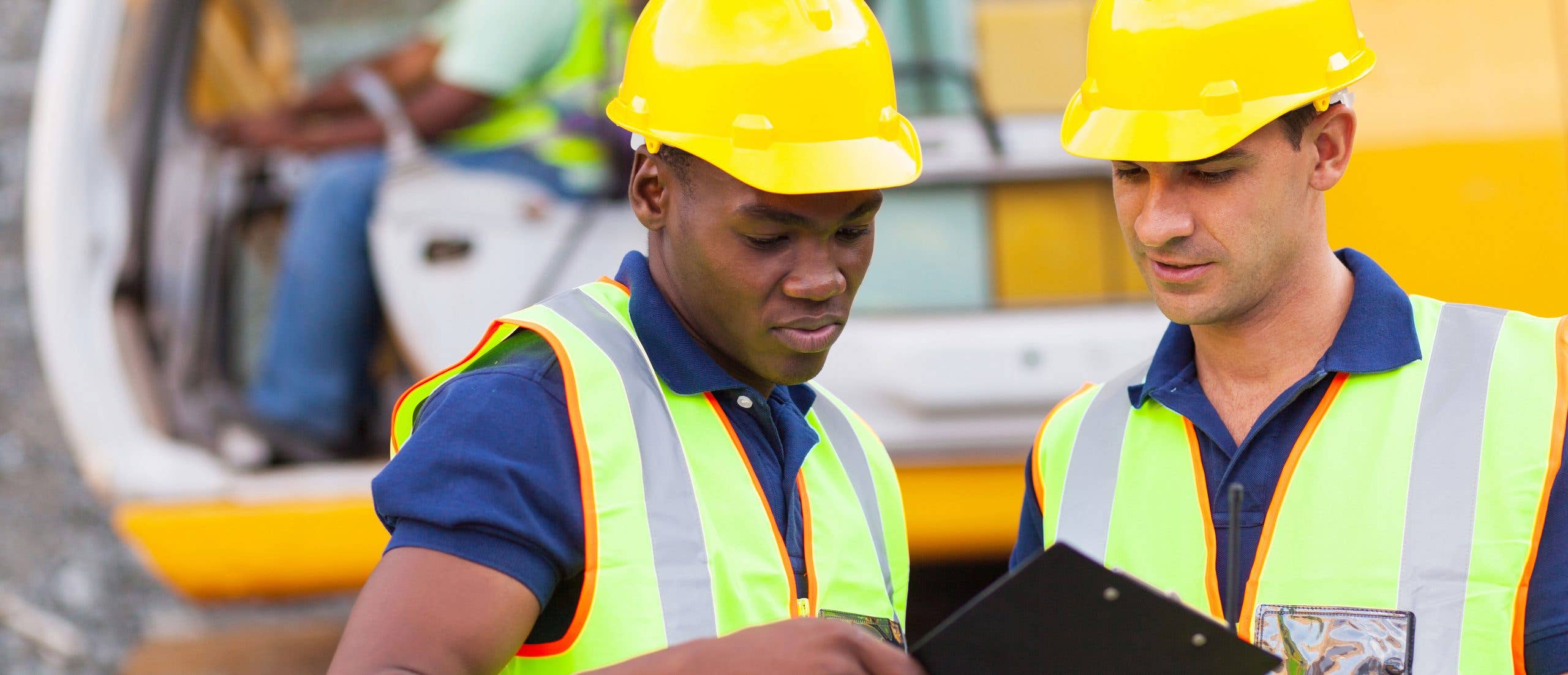What is Effective Communication in Construction?
Effective communication is defined as being able to successfully convey information, knowledge, and ideas in a way that is received, understood, and acted upon as originally intended. When discussing communication in the construction sector, effective communication is essential in ensuring the successful and safe operation of an organisation and completion of projects.
Communication takes many forms, including verbal (both face-to-face and distanced, such as over the phone), non-verbal (conveying and understanding non-verbal cues such as body language), written, and visual (such as graphs and visual signage). All these forms of communication are essential and it’s important to understand their importance and know how to use them effectively.
Work in construction?
Our Health and Safety training courses provide you and your workforce with a thorough understanding of the different aspects of health and safety you may encounter.

What is the Role of Communication in Construction?
There are several costly impacts that poor communication can have on an organisation and the success of its projects, including:
- Increased health and safety issues. Work in the construction sector presents many potential hazards, including work at height, hazardous and dangerous substances, and on-site vehicles. Poor communication of health and safety information can significantly increase the number of accidents and incidents, which has a direct impact on productivity, turnover, morale, legal and compensation costs, and reputation with customers.
- Low morale. Poor communication can cause increased stress levels, poor motivation and decreased morale in workers. Additionally, conflict can also arise when different parties in the project are not kept fully informed of all decisions. This can have a significant impact on the happiness and motivation of employees, and working on a site with poor information flow and conflicts is not a pleasant environment. This is often accompanied by feelings of resentment, high staff turnover and increased absences. To learn how to improve teamwork in construction, read our article How to Build Relationships in Construction.
- Lack of clarity around goals. This can result in significant misunderstandings between different stakeholders. This can impact the success of a project as all parties have competing and inconsistent goals.
- Delays, decreased productivity and profitability. Poor communication and ineffective communication streams can decrease the speed with which information is transferred within a project and can also cause information blocks where information is transferred to the wrong person. This can cause delays and reduced productivity, both of which may affect profit.
- Increased costs. All of the factors above can have a direct impact on costs. For example, accidents and incidents can cause increased staff turnover, increased costs covering absent workers and hiring replacements, increased insurance premiums, and legal costs. Additionally, delays can result in significant additional costs including increased labour costs and increased rent hire for machinery and tools. Even poor communication around project specifics, such as materialis, project or site specific information, and quantities, can result in the purchase of incorrect, unusable or excess materials – all of which will increase costs.
- Decreased reputation with customers. Poor communication resulting in delays, disruptions, conflicts and high levels of accidents and incidents can develop a negative reputation for an organisation. This can impact an organisations ability to remain competitive.

Poor communication can have serious impacts on an organisation and its employees in many ways. Therefore, it’s essential to maintain effective communication across an organisation, to limit any negative repercussions. However, there can often be barriers to communication, especially in the construction sector, which poses unique challenges that need to be overcome.
What are the Barriers to Communication in Construction?
If you are experiencing poor communication in your organisation, a good place to start is to understand why this might be the case. Detailed below are some common barriers to effective communication within the construction industry. It’s important to note that this is not an exhaustive list.
- A large workforce. Construction sites often have very large numbers of individuals working there at any given time. This may be a mix of full-time or part-time employees, temporary workers, and contractors or subcontractors, all of whom have different roles, responsibilities, skills and levels of experience. In this style of workforce, it’s easy for communication barriers to form and, when on-site managers are responsible for the transfer of information, for there to be inconsistent levels of communication. Not every manager is an effective communicator. Communication is a skill and it takes practice.
- Distanced senior management. Where the senior management works away from site, it can be hard to ensure that decisions made at the top are reflective of the conditions on-site or communicated effectively. Where this is not the case, it can lead to delays in communication and work, misunderstandings and even unsafe conditions. This is why effective top-down communication is essential.
- Complex and unclear information. Providing information to workers that is overly complex, packed full of excessive information and jargon, can make it hard for your message to be understood and can result in misinterpretations.
- Language barriers. Where a worker’s first language is not English, this can potentially pose communication barriers. These workers may rely on translations and interpretations, and may misunderstand information passed onto them. This can be very dangerous when communicating health and safety information. Where language barriers are not effectively managed, it may also increase the risk of workplace discrimination and harassment, which can impact not only the individual but the wider workplace as well.
Methods of Effective Communication on Construction Sites
There are several ways that you can help to improve communication in your workplace. When considering how to do this, think about the following:
- Effective communication starts from the top down. Therefore, it’s essential that managers and supervisors communicate effectively, listen to their employees and never ignore policy or procedures. By doing this, you’ll start to develop a positive culture across your organisation and quickly start to see employees follow suit. Additionally, it’s essential that your safe working policies, procedures and practices are the same for everyone. There should not be one rule for some and a different rule for others. This will help to ensure everyone communicates and follows the correct methods.
- Ensure formal communication channels are enforced. Communication needs to be effective from the top-down, but also allow employees to raise and report concerns. You should request and actively listen to feedback, both about work and around your communication style. There might be something you can do more of to help ensure your message is heard.
- Be selective when choosing how to communicate. One size does not fit all with communication. Sometimes a ‘tool-box talk’ may be the best way to share information, other times it may be an email or visual sign. It’s important to choose the right communication method to ensure you are properly understood and that your message is received the way you intended.
- Be professional, clear and concise. Don’t over complicate your message and explain your meaning as clearly and concisely as possible. This will help to ensure that your message is understood and the appropriate actions are taken.
- Provide accessible information. For example, health and safety information and other policies and procedures should be widely and easily available for everyone in accessible formats. It’s essential that staff are properly briefed on any updates to health and safety procedures to ensure that staff can work safely and effectively.
- Ensure information is communicated in a timely manner and delivered to all necessary parties. While being open and transparent is an essential part of effective communication, it’s important not to overload everyone with too much information. Sometimes, you may need to share communication with everyone in your organisation, other times, this is not needed. Where possible, it’s better to be specific with communication and target those impacted.
- Identify the linguistic strengths and weaknesses in your organisation. It’s important to consider the current reality and the future needs of your organisation. When hiring, consider the language and communication skills of workers. Do they have skills that would benefit your workforce and help to close the language barrier gaps? You should also ensure that your written materials are properly and accurately translated and provided to workers who need them. It’s important that you ensure these are accurate translations done by professional construction translators, as you do not want to cause misunderstandings.

Throughout this article we have emphasised the importance of communication in the construction workforce. Effective communication is essential to the successful and safe completion of your projects. Therefore, you should consider communication as a key skill that you want your employees to demonstrate.
Communication skills may easily be forgotten, as they are seemingly not as important as health and safety or specific speciality skills, but they underpin safe working on your site. High Speed Training offers Communication Skills Training, that can help you train your workers in communication and teach them how to apply their communication skills to reduce communication barriers in your workplace.











